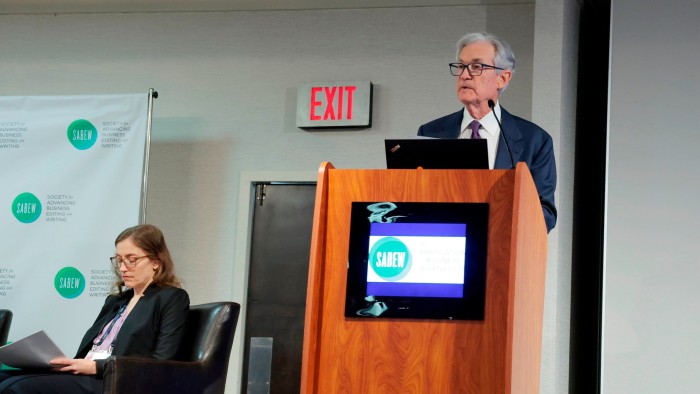Unlock the Editor’s Digest without spending a dime
Roula Khalaf, Editor of the FT, selects her favorite tales on this weekly publication.
The important thing factors
-
In an intervention on the SABEW convention on Friday, Fed chair Jay Powell gave an up to date evaluation of the state of the US economic system and the central financial institution’s probably response operate two days after the Trump administration’s announcement of sweeping tariffs.
-
Powell struck a extra hawkish tone in comparison with his most up-to-date public statements in mid-March, indicating — albeit obliquely — that the Fed is extra involved with upside dangers to costs.
The decision
Fed chair Jay Powell’s remarks and subsequent interview on Friday clearly had the first aim of reassuring markets and indicating that the US central financial institution has not been jolted by Donald Trump’s “liberation day” tariffs, and that it’ll as an alternative proceed to carry out for laborious information confirming the consequences of the brand new commerce measures earlier than altering its coverage stance. But veiled behind his phrases, there was a particular hawkish tilt from the Fed chair, who had beforehand prompt that new tariffs could also be “transitory”.
For now, we proceed to count on the Fed to chop the benchmark fee twice in 2025. Nevertheless, now we have low confidence in our forecast, which is very contingent on how the brand new commerce conflict will play out within the coming weeks and whether or not it’ll harm actual exercise greater than it’ll elevate inflation. With little proof more likely to emerge earlier than Could, we expect the Fed will maintain at its subsequent assembly.
The main points
Powell’s speech on the SABEW convention on Friday contained two key messages for markets.
The primary is that the Fed’s framework for fascinated by the US economic system has not essentially modified, regardless of the introduction of considerable and extremely disruptive common tariffs by the Trump administration on Wednesday.
“Whereas uncertainty is excessive and draw back dangers have risen, the economic system remains to be in place,” he mentioned, including that “many forecasters have anticipated considerably slower progress this 12 months”.
The implication was that most of the developments which have not too long ago proven up in mushy, and extra not too long ago, laborious information — falling client and enterprise confidence and declining consumption — will not be an uncommon financial growth and mustn’t warrant panic.
However whereas the Fed chair sought to venture calm, he additionally gave clear hints that, on the margin, “liberation day” insurance policies will improve inflationary dangers and lift the chance of a hawkish response by the central financial institution.
Powell described the tariffs as “considerably bigger than anticipated . . . the identical is more likely to be true of the financial results” and indicated that “it’s potential that the consequences could possibly be extra persistent [ . . . the Fed’s role is to] make sure {that a} one-time improve within the worth stage doesn’t develop into an ongoing drawback”.
This indicated a brand new hawkish bias relative to the final time Powell spoke after the March press convention. On the time, he had prompt he seen tariffs as probably transitory.
As well as, the Fed chair reiterated that “our stance is in place [ . . . it is] reasonably restrictive”. This implies that the Fed remains to be primarily concentrating on the inflation facet of its twin mandate, dispelling the notion of any near-term fee reduce. The strong payrolls report that got here out at this time suggests no easing is required from the labour market.
With this and the nice labour market information out at this time, we expect the Fed is now on a path to pausing for so long as it wants.
Extra from Financial Coverage Radar
Sturdy March payrolls signifies US financial energy forward of commerce conflict

How will ‘liberation day’ have an effect on central banks’ fee cycle?

Tariffs will bring back talk of transatlantic divergence, though forces beyond trade also matter
















